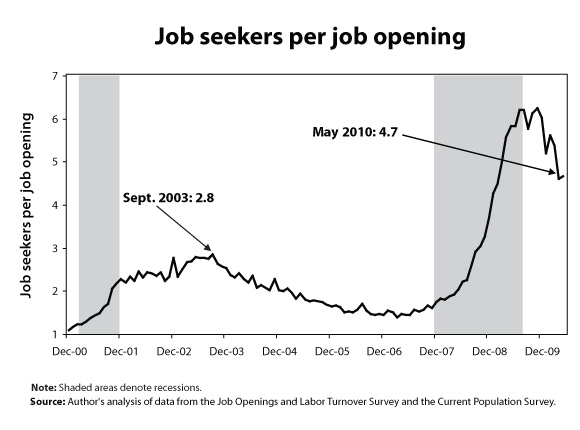This morning, the Bureau of Labor Statistics released the May report from the Job Openings and Labor Turnover Survey (JOLTS), showing that job openings declined 96,000 to 3.2 million in May. From the Current Population Survey, we know that the number of unemployed workers in May was 15.0 million. This means that the ratio of unemployed workers to job openings was 4.7-to-one in May, a slight increase from the revised April ratio of 4.6-to-one.

As with all labor market data in recent months, it is important to examine underlying trends excluding temporary hiring for the 2010 Decennial Census. Importantly, there was a large upward revision to the April job openings data of 238,000 federal job openings, presumably temporary Census job openings. In the last six months of 2009, the federal government averaged 73,000 job openings per month, while in April and May of this year, the federal government averaged 370,000 job openings. If those additional roughly 300,000 federal job openings are excluded from the calculation, the ratio of job seekers to job openings would have been 5.1-to-one in April and 5.2-to-one in May. These ratios provide a sense of the long-term trend and an idea of what to expect going forward as we pass through the temporary census hiring period.
But even at 4.7-to-one, there remains a severe shortage of jobs. The ratio of unemployed per job opening is still substantially higher than at the worst point in the last recession, when it never went above 2.8 unemployed workers per job opening. In 2007, before the recession started, the ratio averaged 1.5-to-one.
With so many unemployed workers per available job, people who find themselves out of work can be expected to remain unemployed for extremely long periods. In May, nearly half (46%) of this country’s unemployed workers had been unemployed for over six months, 20 percentage points above the previous high of 26.0%, set in the summer of 1983.
In May there were 11.8 million more unemployed workers than there were job openings. The employment report released on July 2nd showed very slow growth in June, with the private sector adding only 83,000 jobs. This rate of growth is nowhere near what is needed to put the backlog of unemployed workers in this country back to work anytime soon. The long-term unemployed are still beset by a monumental labor market failure and need assistance to weather the ongoing crisis. Because of Congress’s failure to renew the program that provides extended benefits to the long-term unemployed, more than 2 million unemployed workers have lost their unemployment insurance benefits in the last six weeks. This is indefensible, given that the continuation of extended unemployment benefits fulfills two important national needs: assisting those most hurt by the recession and, as one of the most efficient mechanisms available for injecting spending into the economy, generating jobs.